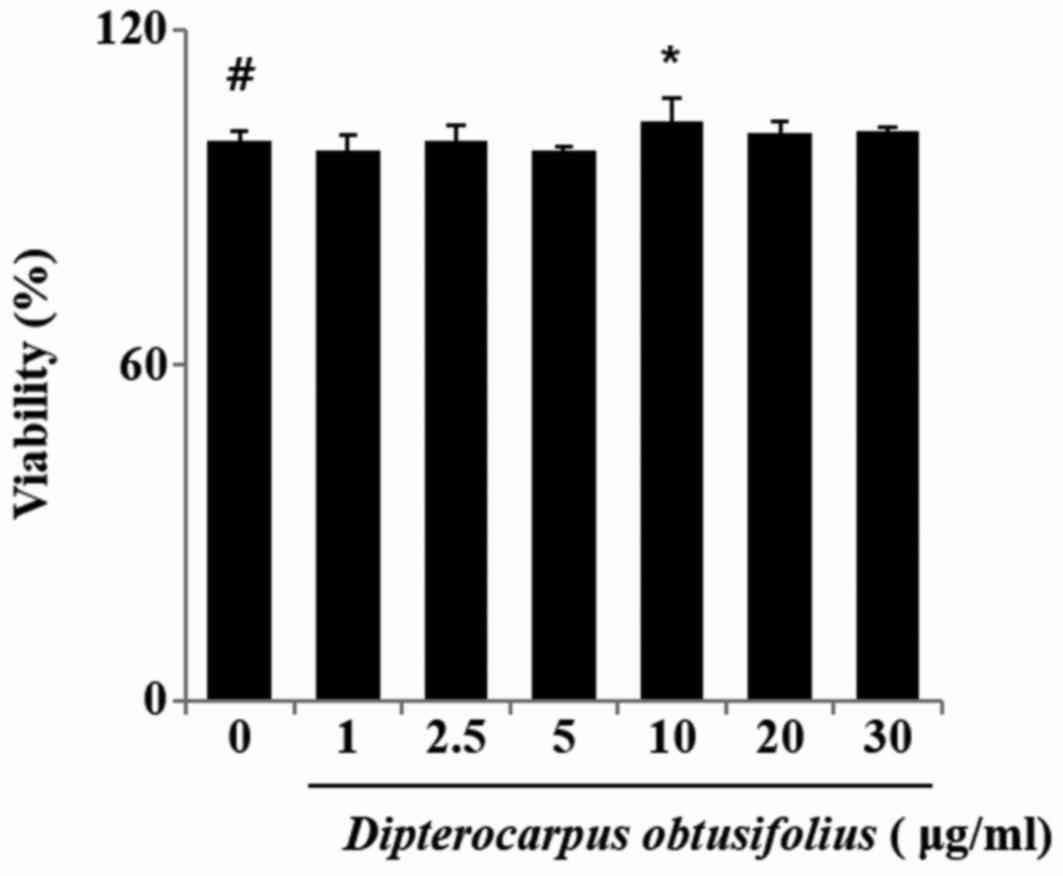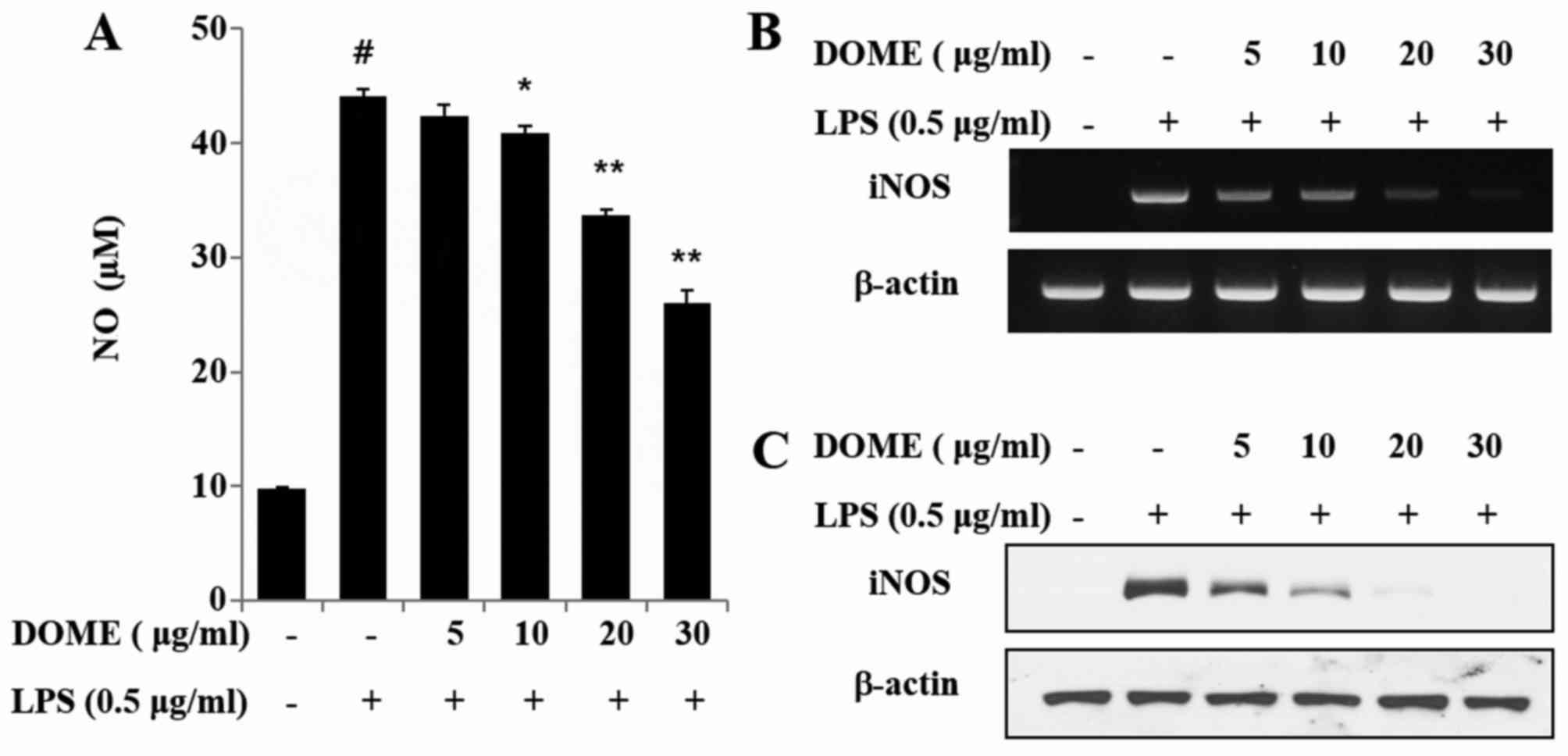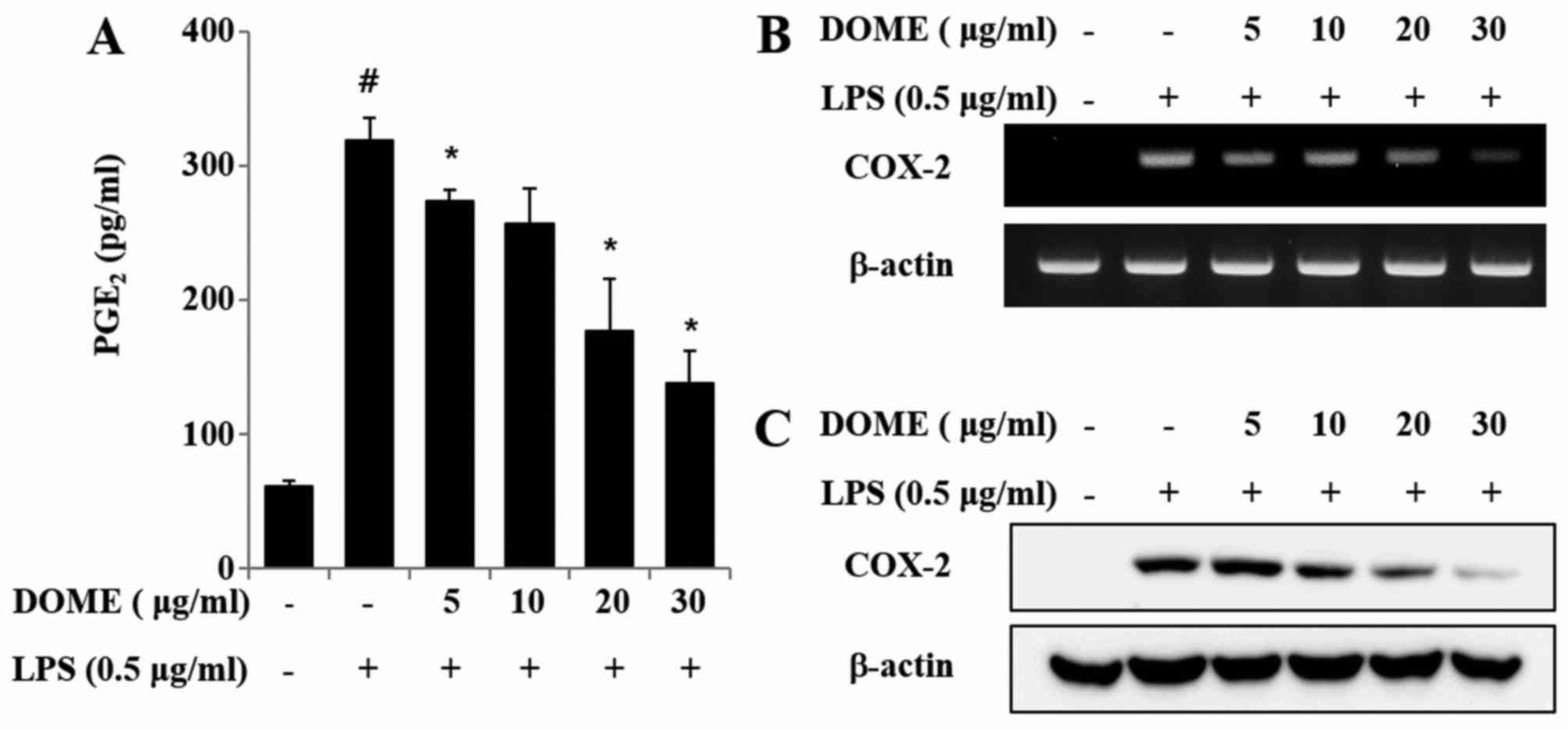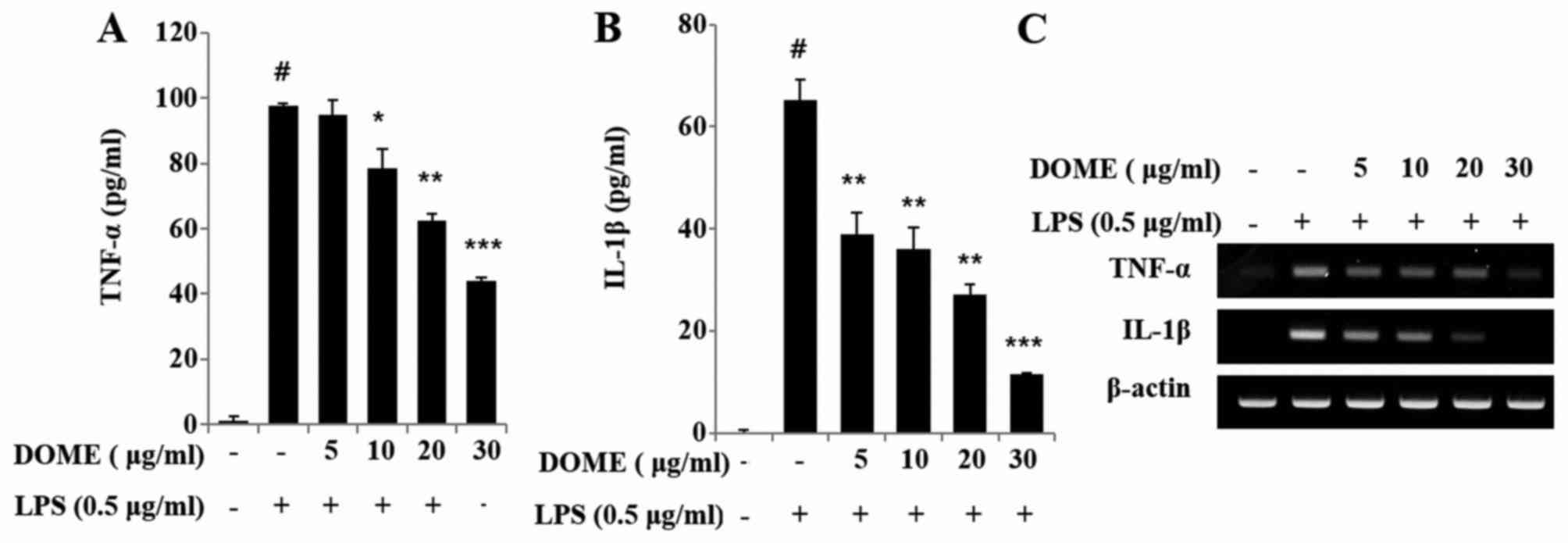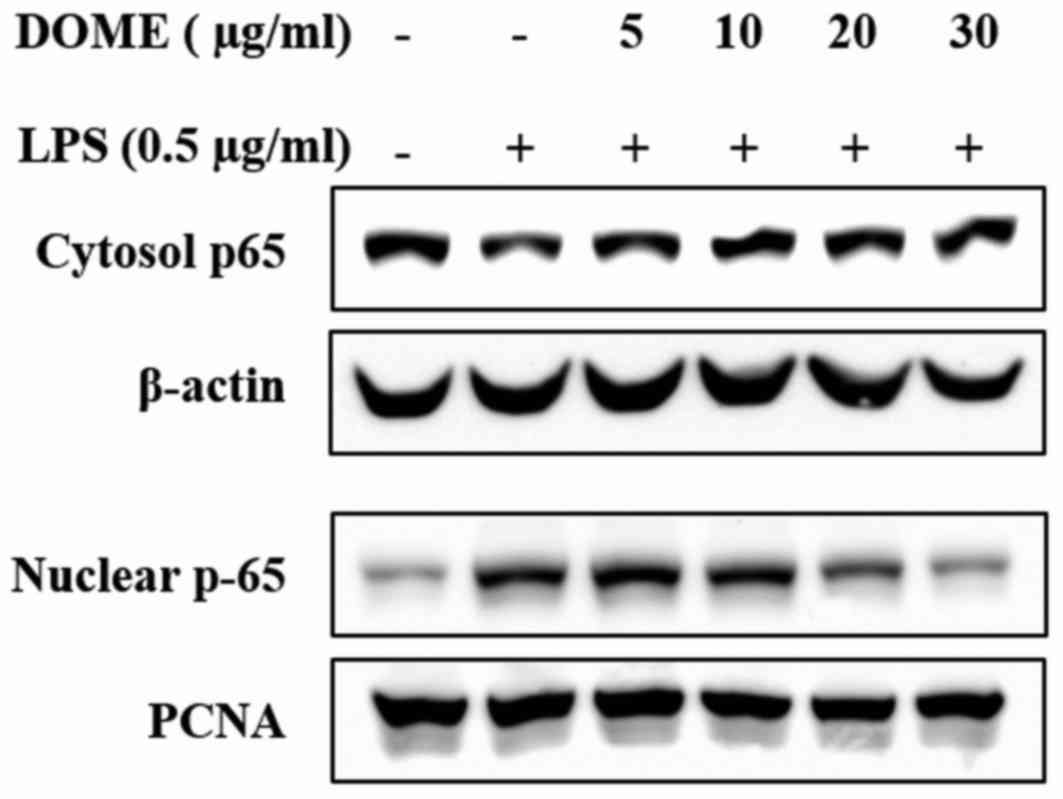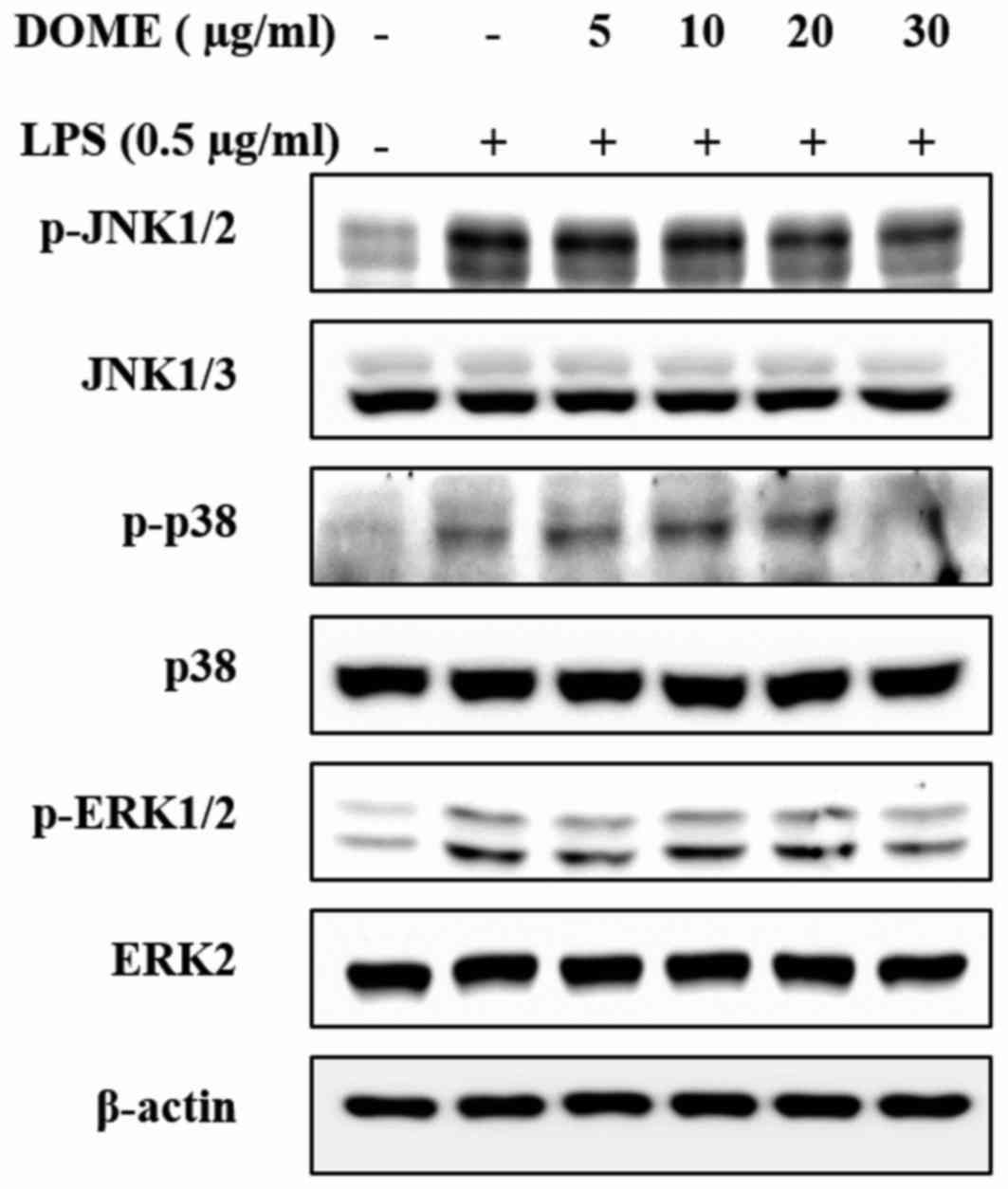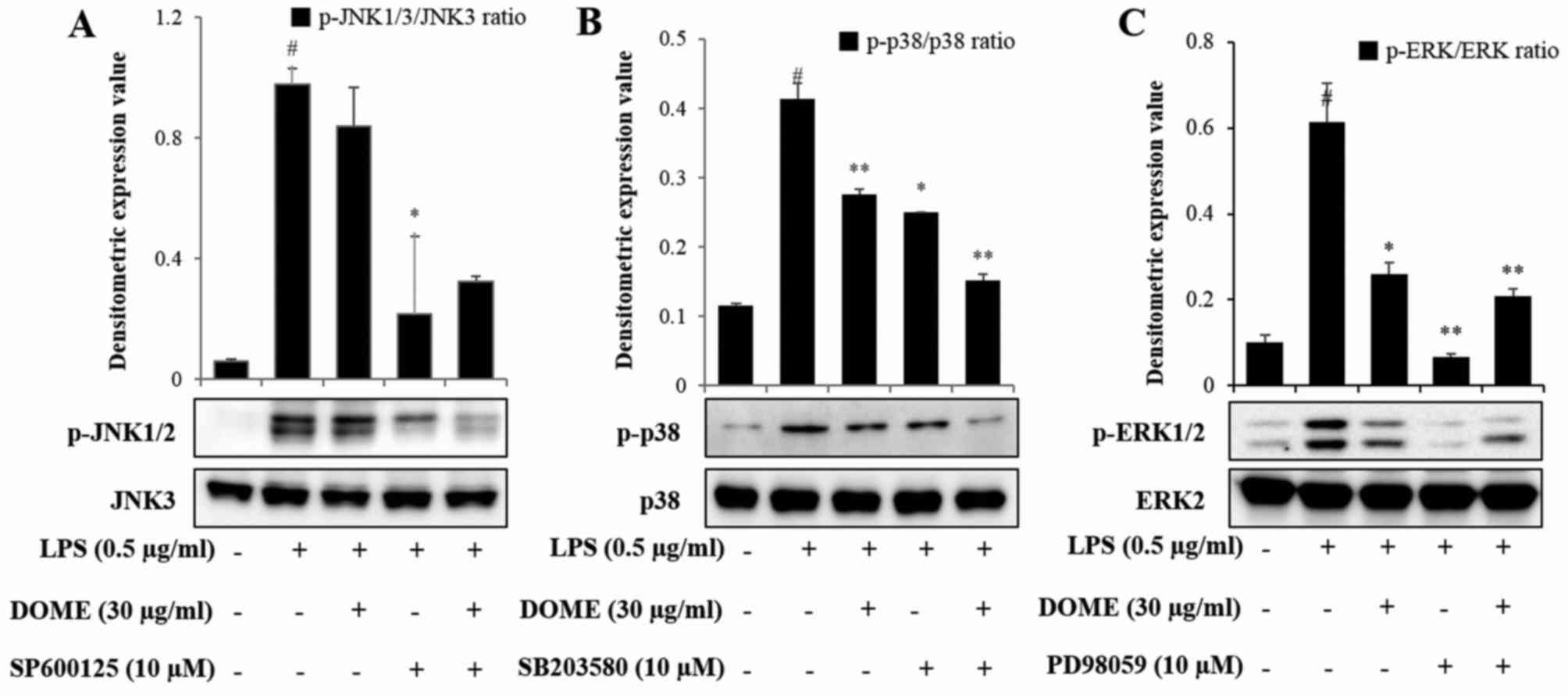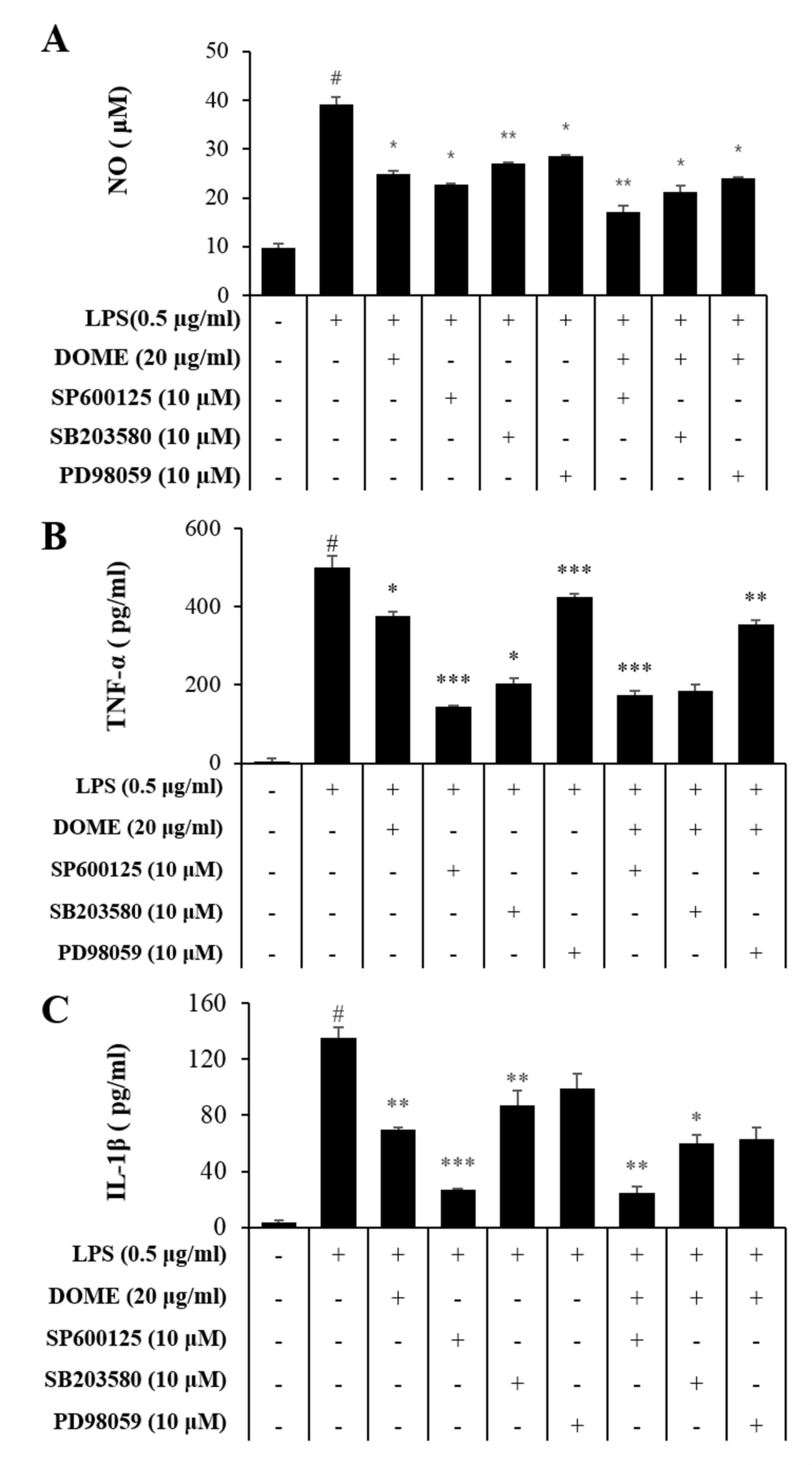Dipterocarpus obtusifolius attenuates the effects of lipopolysaccharide‑induced inflammatory response in RAW264.7 macrophages
- Authors:
- Published online on: September 28, 2017 https://doi.org/10.3892/mmr.2017.7655
- Pages: 8463-8470
Abstract
Introduction
Non-steroidal anti-inflammatory drugs (NSAIDs) are typically used to treat inflammatory states and injury. Non-selective NSAIDs inhibit cyclooxygenase-1 (COX-1) mediated production of prostaglandins and are known to cause vascular and gastrointestinal toxicity, and a variety of nephrotoxic syndromes (1). Due to these adverse effects, there is a requirement for novel alternative treatments for inflammatory diseases. Meanwhile, there has been an increase in the use of herbal dietary supplements. The rise in the popularity of natural products may be attributed to dissatisfaction with conventional medicines (2–5).
The function of nitric oxide (NO) in the inflammatory reaction is controversial. During inflammation and sepsis, increased production of diverse mediators, including endotoxins, pro-inflammatory cytokines and eicosanoids, induces inducible nitric oxide synthase (iNOS) activity. Increased mucosal NO production and NOS-2 activity have been associated with active inflammatory bowel disease or pathogenesis of chronic disease in patients (6–8) and in an experimental animal model of induced or inherent inflammation (9). In addition, prostaglandin E2 (PGE2) is a primary inflammatory mediator and upregulates vascular permeability increasing factor, which may lead to edema, pain and fever during inflammatory disease (10). Members of the COX family are accountable for the production of prostaglandins, including thromboxanes and prostacyclin (11,12). COX exists as two isoforms: Inducible COX-2 and constitutive COX-1. COX-2 levels are reduced under healthy physiological conditions, but is transiently and rapidly induced by pro-inflammatory mediators, activating the biosynthesis of prostaglandin and inflammatory responses (13). Inhibition of COX-2 may provide relief from the symptoms of inflammation and pain (14). Consequently, a previous study aimed to investigate selective COX-2 inhibitors (15). Fraxinellone has been suggested to have mild but significant inhibitory effects on the stimulation of PGE2 by LPS, and Kim et al (16) suggested reductions in PGE2 may be due to the transcriptional suppression of COX-2.
D. obtusifolius is a plant genus that belongs to the family Dipterocarpaceae, which consists of ~75 species distributed in tropical regions (17). This family of plants is known to contain sesquiterpenes, triterpenes, flavonoids and resveratrol oligomers, and exhibits diverse biological anticancer, anti-human immunodeficiency virus (18), antibacterial and antioxidant activities (19). D. obtusifolius is a tree with a typical height of 10–15 m that grows in cleared forests in low altitude regions, and is widely distributed across Southeast Asian countries. Traditionally, the resin of this plant has been used to relieve abdominal discomfort in Cambodia, Laos and Vietnam (20). To the best of our knowledge, there have been no reports on the anti-inflammatory effects of D. obtusifolius methanolic extract (DOME). Therefore, the aim of the present study was to investigate the anti-inflammatory effects of DOME using LPS-stimulated RAW264.7 cells. NO, cytokines and PGE2 levels were assessed following treatment with DOME in LPS-stimulated RAW264.7 cells. To elucidate the protective underlying mechanisms of DOME, the expression of mRNA and proteins associated with inflammatory responses were examined.
Materials and methods
Preparation of DOME from D. obtusifolius leaves
D. obtusifolius was collected from the Tbaeng region of Cambodia in 2009. The extract was obtained from 86 g leaves with MeOH, an extract efficiency of 9.22%. A voucher specimen (KRIB 0025367) was deposited in the herbarium of the Korea Research Institute of Bioscience and Biotechnology (Daejeon, Republic of Korea). The D. obtusifolius leaves were obtained from the International Biological Material Research Center (Daejeon, Republic of Korea).
Cell culture
The RAW264.7 macrophage cell line was provided by the American Type Culture Collection (Manassas, VA, USA). Cells were maintained in a 95% air, 5% CO2 atmosphere in a 37°C incubator in Dulbecco's modified Eagle's medium (Gibco; Thermo Fisher Scientific, Inc., Waltham, MA, USA) supplemented with 10% heat-inactivated fetal bovine serum (Hyclone; GE Healthcare, Logan, UT, USA) and 1% penicillin-streptomycin-glutamine (Invitrogen; Thermo Fisher Scientific, Inc.). RAW264.7 cells were passage weekly at 70–80% confluence. Following pre-incubation for 4 h, 0–30 µg/ml DOME was added to cells. In another set of cultures, the cells were co-incubated with 10 µM p42/44 inhibitor, PD98059, 10 µM p38 inhibitor, SB203580 and 10 µM c-Jun N-terminal kinase (JNK) inhibitor, SP600125.
Cell viability assay
Cell viability was determined by an assay based on the mitochondrial-dependent reduction of MTT (Amresco, LLC, Solon, OH, USA) to formazan with 100 µl DMSO per well. Based on the results of cell viability, nontoxic concentrations of DOME were used with RAW264.7 cells in the present study. The optical density of formazan was measured using a microplate reader (Benchmark; Bio-Rad Laboratories, Hercules, CA, USA) at a wavelength of 570 nm. The optical density of formazan generated by untreated cells was used to determine the 100% viability.
NO assay
The NO level in cell culture supernatants from centrifugation at 100 × g for 5 min at room temperature was determined using the Griess test. RAW264.7 cells were plated at a density of 5×104 cells/well in 96-well plates and subsequently incubated with or without 0.5 µg/ml LPS in the absence or presence of various concentrations of DOME for 24 h. Nitrite in the culture supernatants was mixed with an equal volume of Griess reagent [1% sulfanilamide and 0.1% N-(1-naphthyl)ethylenediamine dihydrochloride in 5% phosphoric acid]. The absorbance was measured at a wavelength of 540 nm using a microplate reader and a series of known concentrations of NaNO2 was used as a standard.
PGE2 assay
The quantity of PGE2 in the supernatant was determined using a PGE2 ELISA kit (cat. no. 514010; Cayman Chemical Company, Ann Arbor, MI, USA) according to the manufacturer's protocol. A total of 50 µl diluted standard:sample 2:1 was pipetted into a 96-well plate pre-coated with goat polyclonal anti-mouse IgG-HRP antibody (sc-2005; Santa Cruz Biotechnology, Inc.). Aliquots of a PGE2 monoclonal antibody and PGE2 acetylcholine esterase (AChE) conjugate were added to each well and allowed to incubate at room temperature for 18 h. The wells were washed six times with buffer containing 0.05% Tween-20, followed by the addition of 200 µl Ellman's reagent containing acetylthiocholine and 5,5′-dithio-bis-(2-nitrobenzoic acid). PGE2 concentrations were determined by measuring the absorbance at a wavelength of 405 nm using a microplate reader (Benchmark; Bio-Rad Laboratories, Inc.).
Cytokine assays
The levels of interleukin (IL)-1β and tumor necrosis factor (TNF)-α were determined using commercial ELISA kits for IL-1β (cat. no. 559603) and TNF-α (cat. no. 558534) purchased from BD Biosciences, Inc. (San Jose, CA, USA) according to the manufacturer's protocols. The concentrations of mediators were determined by measuring the absorbance at a wavelength of 450 nm using a microplate reader (Benchmark; Bio-Rad Laboratories, Inc.).
Reverse transcription-quantitative polymerase chain reaction (RT-qPCR)
RT-qPCR was performed for the detection of the mRNA expression of iNOS, COX-2, IL-1β, TNF-α and β-actin. Following 0.5 µg/ml LPS stimulation of RAW264.7 cells for 6 h, total RNA was isolated using TRIzol™ reagent (Invitrogen; Thermo Fisher Scientific, Inc.), according to the manufacturer's protocol. RT reactions were performed using a kit for producing cDNA (QuantiTect Reverse Transcription; 205313; Qiagen GmbH, Hilden, Germany). PCR was carried out using specific forward and reverse primers and SYBR® FAST Master Mix (KAPA, KR0389; Bioneer Corporation, Daejeon, Korea) according to the manufacturer's protocol. The following conditions were used for each PCR reaction: 94°C for 5 min (1 cycle); 94°C for 20 sec, 5°C for 30 sec and 72°C for 45 sec (30 cycles); and a final extension phase at 72°C for 10 min. Primer sequences iNOS, COX-2, IL-1β, TNF-α and β-actin are presented in Table I. β-actin expression served as an internal housekeeping gene control. The reaction products were separated by electrophoresis on a 1.5% agarose gel, stained with ethidium bromide and visualized using a UV Transilluminator imaging system. Gels were imaged using an C-4000 Zoom camera (Olympus America, Inc., Center Valley, PA, USA).
Western blot analysis
Following 0.5 µg/ml LPS stimulation for 30 min, 5×105 cells/ml cells were harvested. Cells were washed twice with ice-cold PBS, scraped off with a rubber policeman and centrifuged at 1,000 × g for 5 min at 4°C. Cell pellets were resuspended in an appropriate volume of Protein Extraction Solution (NP-40; catalog no. EBA-1049; ELPIS-Biotech, Inc., Daejeon, Korea), and incubated for 10 min at room temperature and subsequently for 20 min on ice. Lysates were subsequently centrifuged at 30,000 × g for 10 min at 4°C and collected for further analysis. The supernatant was stored at −87°C until use. Protein concentrations of samples were determined by Bicinchoninic Acid assay (Thermo Fisher Scientific, Inc.) using samples equilibrated to 2 mg/ml with Protein Extraction Solution. A total of 20 µg protein was separated by 10% SDS-PAGE and subsequently transferred onto a polyvinylidene difluoride membrane (EMD Millipore, Billerica, MA, USA). Each membrane was incubated for 1 h with 5% skimmed milk in TBS with Tween-20 buffer (0.1 M Tris-HCl, pH 7.4; 0.9% NaCl; 0.1% Tween-20) to block non-specific binding, followed by 4°C overnight incubation with the following primary antibodies: Anti-iNOS (ADL-905-431; 1:1,000; Enzo Life Sciences, Farmingdale, NY, USA), anti-COX-2 (sc-1747; 1:1,000; Santa Cruz Biotechnology, Inc., Santa Cruz, CA, USA), anti-β-actin (4967S; 1:2,000; Cell Signaling Technology, Inc., Danvers, MA, USA), anti-extracellular signal regulated kinase (ERK)2 (sc-154), anti-p38 mitogen activated protein kinase (MAPK) (sc-7149), anti-JNK1/3 (sc-474), anti-nuclear factor (NF)-κB p65 (sc-372), anti-proliferating cell nuclear antigen (PCNA) (sc-56) (all 1:1,000; Santa Cruz Biotechnology, Inc.), anti-phosphorylated (p)-p38 MAPK (MA 022; 1:1,000), anti-p-JNK1/2 (both 1:1,000; Enzo Life Sciences) and anti-p-ERK (4370; 1:1,000; Cell Signaling Technology, Inc.). Each protein was detected using an Enhanced Chemiluminescence detection system according to the ImageQuant LAS4000 (GE Healthcare Life Sciences, Chalfont, UK).
Statistical analysis
Data are expressed as the mean ± standard error of the mean. Statistical significance between two groups was determined using the Student's t-test. Data with values of P<0.05 were considered to indicate a statistically significant difference.
Results
Evaluation of cytotoxicity of DOME on RAW264.7 cells
To determine if DOME affects cell viability, RAW264.7 cells were incubated for 24 h with the extract at a wide range of concentrations (0–30 µg/ml), and cell viability was evaluated by MTT assay. A statistically significant decrease in cell survival was detected at concentrations higher than 30 µg/ml (Fig. 1).
DOME inhibits NO production by suppressing iNOS expression in LPS-stimulated RAW264.7 macrophage cells
Nitric oxide serves a central role in the inflammatory response. Unstimulated RAW264.7 cells secreted basal levels of NO, whereas LPS stimulation induced an increase in NO production. DOME treatment was demonstrated to inhibit NO production in LPS-induced RAW264.7 macrophages in a dose-dependent manner (Fig. 2A). To further evaluate the effects of DOME on expression of iNOS, RT-qPCR and western blot analyses were performed 6 and 18 h following LPS stimulation. Untreated cells and those pre-incubated with DOME expressed detectable levels of iNOS mRNA and protein, which were elevated upon LPS addition (data not shown). Notably, DOME reduced iNOS mRNA (Fig. 2B) and protein (Fig. 2C) expression levels, indicating that DOME inhibits LPS-induced NO production by inhibiting iNOS.
DOME inhibits PGE2 production by suppressing COX-2 expression in LPS-stimulated RAW264.7 cells
To assess whether DOME extract exerted an inhibitory effect on PGE2 production, RAW264.7 cells were pretreated with the extract for 1 h and stimulated with LPS. Incubation of macrophages with LPS alone for 24 h significantly increased the secretion of the pro-inflammatory mediator PGE2, as measured by ELISA (P<0.05). However, pretreatment with DOME in macrophages dose-dependently decreased the secretion of PGE2 compared with treatment with LPS alone (Fig. 3A; P<0.05). To further clarify the effects of DOME on COX-2 mRNA and protein expression levels, RT-qPCR and western blot analyses were performed 6 and 18 h after LPS stimulation. Cells treated with DOME alone expressed detectable levels of COX-2 mRNA and protein, which were further increased following LPS stimulation (data not shown). DOME markedly attenuated mRNA (Fig. 3B) and protein (Fig. 3C) expression levels of LPS-induced COX-2 in RAW264.7 cells. Therefore, DOME may inhibit PGE2 production via suppression of COX-2 expression in LPS-stimulated RAW264.7 cells.
DOME reduces the release of pro-inflammatory cytokines in LPS-stimulated RAW264.7 cells
Secretion of pro-inflammatory mediators is a critical factor in inflammatory processes. LPS stimulation induced an increase in TNF-α (Fig. 4A) and IL-1β (Fig. 4B) levels in RAW264.7 cells. However, DOME significantly reduced the release of these LPS-stimulated mediators in a dose-dependent manner. Similarly, mRNA expression levels of TNF-α and IL-1β were increased in LPS-stimulated RAW264.7 cells, whereas DOME suppressed this effect (Fig. 4C).
DOME inhibits the phosphorylation of MAPKs and activation of NF-κB in LPS-stimulated RAW264.7 cells
DOME-treated RAW264.7 cells exhibited a reduction in the translocation of NF-κB into the nucleus (Fig. 5). The MAPKs may be activated by LPS, a key stimulator of the inflammation response, in macrophages as well as many cell types (20). As presented in Fig. 6, DOME markedly decreased the expression levels of p-p38, p-JNK and p-ERK in LPS-induced RAW264.7 cells compared with untreated cells. These data suggested that DOME suppresses the inflammatory response via partial regulation of MAPK signaling. To assess the role of MAPKs in LPS-induced inflammatory mediator production, the effects of selective MAPK inhibitors on LPS-induced NO production were examined. Western blot analysis revealed that SP600125 (Fig. 7A), SB203580 (Fig. 7B) and PD98059 (Fig. 7C), markedly inhibited JNK, p38 and ERK phosphorylation, respectively. Furthermore, these inhibitors were demonstrated to markedly inhibited LPS-mediated NO (Fig. 8A), TNF-α (Fig. 8B) and IL-1β (Fig. 8C) production. These results suggested that DOME-mediated inactivation of ERK, JNK and p38 MAPK may be, at least in part, responsible for the suppression of NO, IL-1β and TNF-α in RAW264.7 cells. In addition, LPS stimulation induced an increase in the activation of NF-κB, whereas treatment with DOME inhibited this effect. The activation is consistent with the results of western blotting for NF-κB. Furthermore, LPS stimulation may cause translocation of NF-κB into nucleus.
Discussion
Inflammation is a host response against diverse injuries. Macrophage cells regulate inflammatory mediators, including NO, PGE2, IL-1β, and TNF-α (21). A previous study has indicated that certain inducible enzymes, including iNOS and COX-2, cytokines (IL-1β and TNF-α), and their response products are involved in chronic inflammatory sickness (22). iNOS is involved with inflammation, and its reaction product involved in a wide range of conditions; for example, psoriasis and atopic inflammation. COX-2, an inducible isoform of COX, is upregulated in inflammation (23,24). Therefore, to assess the biological activity of DOME and to estimate its effects against allergic inflammation, the present study examined the anti-inflammatory effect of DOME in LPS-induced RAW264.7 macrophage cells. DOME inhibited the production of NO and PGE2 in LPS-induced RAW264.7 cells. Therefore, DOME may mediate iNOS and COX-2 activity. Numerous pro-inflammatory cytokines, including TNF-α and IL-1β, additionally contribute to inflammatory reactions; therefore, inhibition of their activity is a key factor to estimate the effectiveness of anti-inflammatory medicines. In the present study, DOME considerably suppressed the production of the pro-inflammatory mediators TNF-α, and IL-1β in LPS-stimulated RAW264.7 cells. Therefore, DOME may have an anti-inflammatory function (25,26).
NF-κB regulates the expression of genes encoding pro-inflammatory inducible enzymes, including COX-2, iNOS and other inflammatory-associated proteins (8,27,28). In its inactive form, NF-κB forms a complex with IκB kinase. Upon stimulation, this composite is broken down and NF-κB is activated, translocating into the nucleus and controlling transcription of a large number of inflammatory genes (29). As expression of these pro-inflammatory mediators is known to be regulated by NF-κB (30,31), the results of the present study indicated that transcriptional inhibition of these pro-inflammatory mediators by DOME are due to blockage of the NF-κB signaling pathway. In addition, it was demonstrated that translocation of activated NF-κB p65 to the nucleus is significantly inhibited by DOME. These data indicated that DOME may inhibit NF-κB activation by suppressing translocation of the p65 subunit of NF-κB from the cytosol to the nucleus in LPS-induced RAW264.7 cells. DOME, an inhibitor of MAPKs, markedly suppressed the nuclear translocation of NF-κB p65 by LPS in RAW264.7 cells, suggesting that the MAPK signaling pathway may serve a central role in upregulation of NF-κB.
MAPKs are a family of serine/threonine protein kinases responsible for the majority of cellular responses to external stress signals and cytokines, and are important for regulation of the production of inflammation mediators (32,33). The MAPK superfamily have been extensively studied due to their consistent activation by pro-inflammatory cytokines and to their involvement in nuclear signaling. This superfamily involves JNKs, ERKs, and p38 MAPKs (additionally known as cytokine suppressive binding protein). ERKs are activated by growth factors and mitogenic stimuli, whereas p38 and JNK are regulated by stress-inducing signals and pro-inflammatory cytokines (30,34). Therefore, this signaling pathway may be a potential therapeutic target for the treatment of inflammatory diseases (35). In the present study, rapid phosphorylation of JNK, ERK1/2 and p38 MAPK induced by LPS stimulation in RAW264.7 macrophage cells were suppressed by DOME in a dose-dependent manner, suggesting that DOME may inhibit the MAPK signaling cascade. Treatment with DOME, the p38 MAPK inhibitor SB203580, the JNK inhibitor SP600125 and the ERK inhibitor PD98059 blocked LPS-activated phosphorylation of MAPKs to baseline values. Furthermore, these inhibitors reduced JNK, ERK and p38 phosphorylation by ~50%.
In conclusion, treatment with DOME synergistically inhibited inflammatory mediators in LPS-induced RAW264.7 cells, which may be attributed to down regulation of iNOS and COX-2. These effects were considered to be associated with suppression of MAPK signaling pathway molecules, resulting in inhibition of NF-κB activation and its nuclear translocation. Therefore, these results implicate DOME as a potential novel therapeutic approach for the treatment of inflammatory diseases.
Acknowledgements
The present study was supported by the Bio and Medical Technology Development Program of the National Research Foundation (NRF) and funded by the Korean government (MSIT) (grant nos. NRF-2016K1A1A8A01939075 and PRM0191611), and the Korea Research Institute of Bioscience and Biotechnology Research Initiative Program of the Republic of Korea (grant no. KGM1221713).
References
|
Vanhoutte PM: COX-1 and vascular disease. Clin Pharmacol Ther. 86:212–215. 2009. View Article : Google Scholar : PubMed/NCBI | |
|
Akatsu T, Santo RM, Nakayasu K and Kanai A: Oriental herbal medicine induced epithelial keratopathy. Br J Ophthalmol. 84:9342000. View Article : Google Scholar : PubMed/NCBI | |
|
Suk K: Regulation of neuroinflammation by herbal medicine and its implications for neurodegenerative diseases. A focus on traditional medicines and flavonoids. Neurosignals. 14:23–33. 2005. View Article : Google Scholar : PubMed/NCBI | |
|
Abu-Irmaileh BE and Afifi FU: Herbal medicine in Jordan with special emphasis on commonly used herbs. J Ethnopharmacol. 89:193–197. 2003. View Article : Google Scholar : PubMed/NCBI | |
|
Schmidt M, Christiansen CF, Mehnert F, Rothman KJ and Sørensen HT: Non-steroidal anti-inflammatory drug use and risk of atrial fibrillation or flutter: Population based case-control study. BMJ. 343:d34502011. View Article : Google Scholar : PubMed/NCBI | |
|
Dijkstra G, Moshage H, van Dullemen HM, de Jager-Krikken A, Tiebosch AT, Kleibeuker JH, Jansen PL and van Goor H: Expression of nitric oxide synthases and formation of nitrotyrosine and reactive oxygen species in inflammatory bowel disease. J Pathol. 186:416–421. 1998. View Article : Google Scholar : PubMed/NCBI | |
|
Guslandi M: Nitric oxide and inflammatory bowel diseases. Eur J Clin Invest. 28:904–907. 1998. View Article : Google Scholar : PubMed/NCBI | |
|
Kole L, Giri B, Manna SK, Pal B and Ghosh S: Biochanin-A, an isoflavon, showed anti-proliferative and anti-inflammatory activities through the inhibition of iNOS expression, p38-MAPK and ATF-2 phosphorylation and blocking NFκB nuclear translocation. Eur J Pharmacol. 653:8–15. 2011. View Article : Google Scholar : PubMed/NCBI | |
|
Miller FR, Guay ME, Bauer T and Tucker HM: Long-term flap tracheostomy in a pediatric animal model. Arch Otolaryngol Head Neck Surg. 121:743–748. 1995. View Article : Google Scholar : PubMed/NCBI | |
|
Cosme R, Lublin D, Takafuji V, Lynch K and Roche JK: Prostanoids in human colonic mucosa: Effects of inflammation on PGE(2) receptor expression. Hum Immunol. 61:684–696. 2000. View Article : Google Scholar : PubMed/NCBI | |
|
Schneider A, Zhang Y, Zhang M, Lu WJ, Rao R, Fan X, Redha R, Davis L, Breyer RM, Harris R, et al: Membrane-associated PGE synthase-1 (mPGES-1) is coexpressed with both COX-1 and COX-2 in the kidney. Kidney Int. 65:1205–1213. 2004. View Article : Google Scholar : PubMed/NCBI | |
|
Katagiri H, Ito Y, Ishii K, Hayashi I, Suematsu M, Yamashina S, Murata T, Narumiya S, Kakita A and Majima M: Role of thromboxane derived from COX-1 and −2 in hepatic microcirculatory dysfunction during endotoxemia in mice. Hepatology. 39:139–150. 2004. View Article : Google Scholar : PubMed/NCBI | |
|
Peskar BM: Role of cyclooxygenase isoforms in gastric mucosal defence. J Physiol Paris. 95:3–9. 2001. View Article : Google Scholar : PubMed/NCBI | |
|
Bertinaria M, Shaikh MA, Buccellati C, Cena C, Rolando B, Lazzarato L, Fruttero R, Gasco A, Hoxha M, Capra V, et al: Designing multitarget anti-inflammatory agents: Chemical modulation of the lumiracoxib structure toward dual thromboxane antagonists-COX-2 inhibitors. Chem Med Chem. 7:1647–1660. 2012. View Article : Google Scholar : PubMed/NCBI | |
|
Mashita Y, Taniguchi M, Yokota A, Tanaka A and Takeuchi K: Oral but not parenteral aspirin upregulates COX-2 expression in rat stomachs. A relationship between COX-2 expression and PG deficiency. Digestion. 73:124–132. 2006. View Article : Google Scholar : PubMed/NCBI | |
|
Kim JH, Park YM, Shin JS, Park SJ, Choi JH, Jung HJ, Park HJ and Lee KT: Fraxinellone inhibits lipopolysaccharide-induced inducible nitric oxide synthase and cyclooxygenase-2 expression by negatively regulating nuclear factor-kappa B in RAW 264.7 macrophages cells. Biol Pharm Bull. 32:1062–1068. 2009. View Article : Google Scholar : PubMed/NCBI | |
|
Muhtadi, Hakim EH, Juliawaty LD, Syah YM, Achmad SA, Latip J and Ghisalberti EL: Cytotoxic resveratrol oligomers from the tree bark of Dipterocarpus hasseltii. Fitoterapia. 77:550–555. 2006. View Article : Google Scholar : PubMed/NCBI | |
|
Ukiya M, Kikuchi T, Tokuda H, Tabata K, Kimura Y, Arai T, Ezaki Y, Oseto O, Suzuki T and Akihisa T: Antitumor-promoting effects and cytotoxic activities of dammar resin triterpenoids and their derivatives. Chem Biodivers. 7:1871–1884. 2010. View Article : Google Scholar : PubMed/NCBI | |
|
Khiev P, Kwon OK, Song HH, Oh SR, Ahn KS, Lee HK and Chin YW: Cytotoxic terpenes from the stems of Dipterocarpus obtusifolius collected in Cambodia. Chem Pharm Bull (Tokyo). 60:955–961. 2012. View Article : Google Scholar : PubMed/NCBI | |
|
Park JW, Lee IC, Shin NR, Jeon CM, Kwon OK, Ko JW, Kim JC, Oh SR, Shin IS and Ahn KS: Copper oxide nanoparticles aggravate airway inflammation and mucus production in asthmatic mice via MAPK signaling. Nanotoxicology. 10:445–452. 2016. View Article : Google Scholar : PubMed/NCBI | |
|
Munhoz CD, García-Bueno B, Madrigal JL, Lepsch LB, Scavone C and Leza JC: Stress-induced neuroinflammation: Mechanisms and new pharmacological targets. Braz J Med Biol Res. 41:1037–1046. 2008. View Article : Google Scholar : PubMed/NCBI | |
|
Park JW, Kwon OK, Yuniato P, Marwoto B, Lee J, Oh SR, Kim JH and Ahn KS: Amelioration of an LPS-induced inflammatory response using a methanolic extract of Lagerstroemia ovalifolia to suppress the activation of NF-κB in RAW264.7 macrophages. Int J Mol Med. 38:482–490. 2016. View Article : Google Scholar : PubMed/NCBI | |
|
Bruch-Gerharz D, Fehsel K, Suschek C, Michel G, Ruzicka T and Kolb-Bachofen V: A proinflammatory activity of interleukin 8 in human skin: Expression of the inducible nitric oxide synthase in psoriatic lesions and cultured keratinocytes. J Exp Med. 184:2007–2012. 1996. View Article : Google Scholar : PubMed/NCBI | |
|
Park JW, Kwon OK, Jang HY, Jeong H, Oh SR, Lee HK, Han SB and Ahn KS: A leaf methanolic extract of Wercklea insignis attenuates the lipopolysaccharide-induced inflammatory response by blocking the NF-κB signaling pathway in RAW 264.7 macrophages. Inflammation. 35:321–331. 2012. View Article : Google Scholar : PubMed/NCBI | |
|
Tang S, Shen XY, Huang HQ, Xu SW, Yu Y, Zhou CH, Chen SR, Le K, Wang YH and Liu PQ: Cryptotanshinone suppressed inflammatory cytokines secretion in RAW264.7 macrophages through inhibition of the NF-κB and MAPK signaling pathways. Inflammation. 34:111–118. 2011. View Article : Google Scholar : PubMed/NCBI | |
|
Kwon OK, Ahn KS, Park JW, Jang HY, Joung H, Lee HK and Oh SR: Ethanol extract of Elaeocarpus petiolatus inhibits lipopolysaccharide-induced inflammation in macrophage cells. Inflammation. 35:535–544. 2012. View Article : Google Scholar : PubMed/NCBI | |
|
Lee KM, Kang BS, Lee HL, Son SJ, Hwang SH, Kim DS, Park JS and Cho HJ: Spinal NF-κB activation induces COX-2 upregulation and contributes to inflammatory pain hypersensitivity. Eur J Neurosci. 19:3375–3381. 2004. View Article : Google Scholar : PubMed/NCBI | |
|
Cascinu S, Scartozzi M, Carbonari G, Pierantoni C, Verdecchia L, Mariani C, Squadroni M, Antognoli S, Silva RR, Giampieri R and Berardi R: COX-2 and NF-KB overexpression is common in pancreatic cancer but does not predict for COX-2 inhibitors activity in combination with gemcitabine and oxaliplatin. Am J Clin Oncol. 30:526–530. 2007. View Article : Google Scholar : PubMed/NCBI | |
|
Pan LL, Liu XH, Gong QH, Wu D and Zhu YZ: Hydrogen sulfide attenuated tumor necrosis factor-α-induced inflammatory signaling and dysfunction in vascular endothelial cells. PLoS One. 6:e197662011. View Article : Google Scholar : PubMed/NCBI | |
|
Shin IS, Shin NR, Park JW, Jeon CM, Hong JM, Kwon OK, Kim JS, Lee IC, Kim JC, Oh SR and Ahn KS: Melatonin attenuates neutrophil inflammation and mucus secretion in cigarette smoke-induced chronic obstructive pulmonary diseases via the suppression of Erk-Sp1 signaling. J Pineal Res. 58:50–60. 2015. View Article : Google Scholar : PubMed/NCBI | |
|
Lee SU, Ahn KS, Sung MH, Park JW, Ryu HW, Lee HJ, Hong ST and Oh SR: Indacaterol inhibits tumor cell invasiveness and MMP-9 expression by suppressing IKK/NF-kB activation. Mol Cells. 37:585–591. 2014. View Article : Google Scholar : PubMed/NCBI | |
|
Shin IS, Park JW, Shin NR, Jeon CM, Kwon OK, Kim JS, Kim JC, Oh SR and Ahn KS: Melatonin reduces airway inflammation in ovalbumin-induced asthma. Immunobiology. 219:901–908. 2014. View Article : Google Scholar : PubMed/NCBI | |
|
Park JW, Kwon OK, Kim JH, Oh SR, Kim JH, Paik JH, Marwoto B, Widjhati R, Juniarti F, Irawan D and Ahn KS: Rhododendron album Blume inhibits iNOS and COX-2 expression in LPS-stimulated RAW264.7 cells through the downregulation of NF-κB signaling. Int J Mol Med. 35:987–994. 2015. View Article : Google Scholar : PubMed/NCBI | |
|
Shin IS, Park JW, Shin NR, Jeon CM, Kwon OK, Lee MY, Kim HS, Kim JC, Oh SR and Ahn KS: Melatonin inhibits MUC5AC production via suppression of MAPK signaling in human airway epithelial cells. J Pineal Res. 56:398–407. 2014. View Article : Google Scholar : PubMed/NCBI | |
|
Cao W, Bao C, Padalko E and Lowenstein CJ: Acetylation of mitogen-activated protein kinase phosphatase-1 inhibits Toll-like receptor signaling. J Exp Med. 205:1491–1503. 2008. View Article : Google Scholar : PubMed/NCBI |



